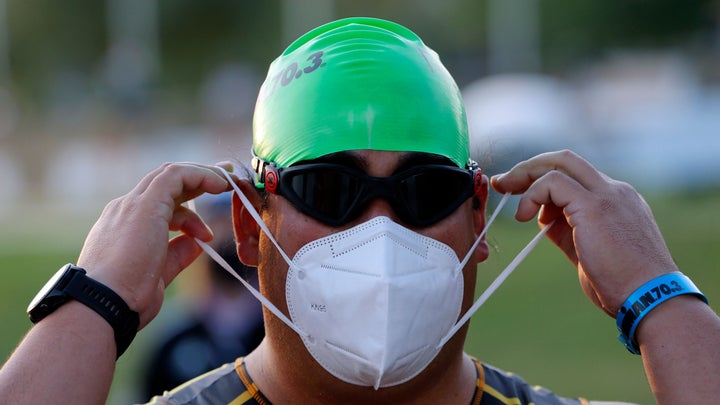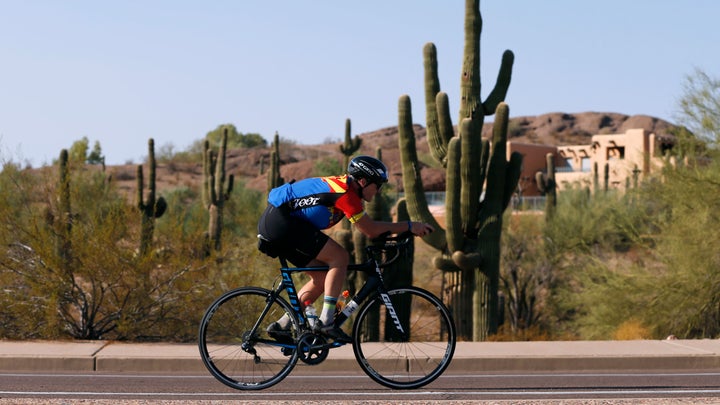New perk! Get after it with local recommendations just for you. Discover nearby events, routes out your door, and hidden gems when you sign up for the Local Running Drop.
To start off: In the face of the COVID pandemic, there is no one answer about whether a race—triathlon, running, gravel biking—should happen or not.
It depends, say experts, on the precautions taken to mitigate risk, on the layout and number of people at the event, on the local infection and positivity rates, and on the likelihood of athletes spreading the illness through the community and to others. (eg. How many athletes are coming from faraway—through airports, hotels, and restaurants? Who are they in contact with? How high is the rate of spread in the area?)
“There is no single number,” said Dr. Amesh Adalja, a senior scholar in infectious diseases at the Center for Health Security at John Hopkins.
There are also no COVID studies specifically on endurance events or races, he said. But we can extrapolate a little from what has been studied and what we do know.
For instance, we do know that very large outdoor rallies and events over the summer and fall led to thousands of cases of COVID, and ultimately hospitalizations and deaths. (Though the upper end of projections from these studies has been disputed, the underlying conclusion has not.) We also know that when the positivity rate for an area is above a certain point, the risk of someone in a crowd having COVID and spreading it multiplies exponentially. And we know, in gyms, people breathing heavily close together can spread COVID quickly, said Dr. Adalja.
But we also know that outdoor events where people are spaced out and wearing masks when they can’t be spaced have a significantly lower risk.
“The risk is really going to be when people congregate in the event,” said Adalja—when they’re close together for a prolonged period and aren’t wearing masks.
What that means for triathlon is a few things: we can mitigate the risk with certain protocols for those pinch points; there is still a COVID risk, however, on top of the usual risks at a race (especially with larger fields in high-COVID areas); and the biggest risk comes from the athletes, spectators, and volunteers spreading it outside the athlete field and into the wider community.

What’s Being Done
Most large race organizers spent much of this year, after the rash of event cancellations, developing COVID-safe protocols. Ironman released their Safe Return to Racing guidelines at the end of May, which fall very much in line with USA Triathlon’s own COVID guidelines. Challenge has also developed their own similar rules, more specific to each race location. We’ve now seen these protocols in action at a number of large events—notably, in the U.S., 70.3 Arizona and Ironman Florida. And Challenge was able to hold a 5,000-person race in Taiwan last weekend—limited to only Taiwanese athletes with no travel from abroad permitted by the country.
By all accounts, athletes have largely followed the rules at these events: Wearing masks in the transition and expo and at the start and finish, following spacing guidelines, making appointments for drop-off or check-in, and self-supporting as much as possible.
By all accounts, the protocols largely did what they were intended to do: Comply with local regulations and cut down on the risk of COVID spreading within the race.
“Ironman did a great job,” said Melissa Quillard, spokesperson for the town of Tempe—which hosted the 70.3 in October and was scheduled to host Ironman Arizona next weekend, before city officials canceled it in the face of rising COVID numbers.
So has anyone gotten COVID from a triathlon?
According to Ironman officials, they’re not aware of any athletes or spectators contracting COVID from an event. There was at least one athlete turned back before reaching the expo at Ironman Estonia after failing a COVID test. And USAT said they’re aware of one behind-the-scenes volunteer at a small race who then tested positive for COVID a few days later.
But asking if anyone’s aware of someone catching COVID at a race is a double-edged question. Because it turns out no one’s tracking that.
What Isn’t Being Done
In order to get a permit for an event, race organizers have to comply with city and state regulations. Most places in the U.S. currently have limitations on gatherings over a certain size. For example, Tempe and the state of Arizona have been restricting gatherings over 50 people. So to get the permit for Arizona 70.3, which had a bit under 1,000 racers, Ironman had to apply for an exemption to the rule. They had to submit a race plan that met certain regulatory requirements: a plan to maintain physical distancing, messaging around education, hand-washing stations and masks, a plan if someone showed up sick, etc.
Those city and state requirements did not include any requirement to track or follow-up with athletes, spectators, or volunteers to see if they were sick in the days after or had contracted COVID during the race weekend. Nor did it require contact tracing to inform others if someone near them had been contagious during the event.
This is not out of the norm. After speaking with a number of race directors, athletes, city officials, and race organizers, it appears no permitted race in the U.S. and probably none worldwide have yet been required to actually track if anyone catches COVID during the event weekend. No athletes have received surveys or follow-up info afterwards to find out if they’re now showing symptoms.
“At this point in time, none of the local agencies at our events have made contact tracing by our organization a requirement for permitting,” said Ironman officials.
Ironman noted public health tracking largely falls to local authorities, and no report of case counts have been attributed to their races. They also monitor email traffic from their athletes, they said, and would be able to provide information and share specific timing data, if necessary, with local agencies.
However, this raises the second issue experts point to: Would the cases manifest locally or would they travel back to athletes’ home towns? How would you know? If an event with 1,000 to 2,000 people then disperses back over the larger region, would it necessarily show up as a statistical spike in any one place or just as a low-level spread across the board?
Typically, in non-COVID times, traveling to a race involves lots of things besides the race. It involves friends and a support crew, maybe renting a house or an Airbnb or staying at a hotel, buying food from the store and getting last-minute things you forgot, stopping by the bike shop for help, going out for dinners and drinks (after), and then traveling back home again.
It is not possible for race directors to regulate these behaviors as part of their permitting process. Yet, it is precisely these things—dining in restaurants as opposed to biking outdoors—that appear to lead to the largest chance of spreading COVID to others. While USA Triathlon has released guidelines for safe travel and towns, like Tempe, certainly have their own rules for visitors, the potential for an influx of out-of-towners doing out-of-town things remains a concern for experts, because it contributes to the overall spread of COVID nationwide.
“You do run the risk of setting off a chain,” said Dr. Adalja, the infectious disease expert.

—
Last week, Ironman Arizona, originally scheduled for Nov. 22, was canceled.
In their official statement, the city noted the COVID situation had changed since the 70.3 triathlon in October. “With increasing case numbers locally, and given that many Ironman Arizona athletes would be flying and driving to Tempe from other places, the city’s Special Events Task Force could not support issuing a permit for this year’s full Ironman event,” the statement read.
In Arizona, the positivity rate over a seven-day average is currently 16.5%. In Texas, where Galveston 70.3 is scheduled to happen this weekend, it’s 12.3%. In Florida, where Challenge Daytona will attract an elite pro field for the PTO Championships and about 2,000 age-group athletes, it’s 8.7%.
As COVID cases spike across the country, states are re-instituting stricter restrictions for businesses and calling on people not to host holiday gatherings. The CDC has said this nationwide spike can largely be attributed not to any one thing, but to many smaller gatherings, to a low-level simmering spread in many places by many people at many events.
